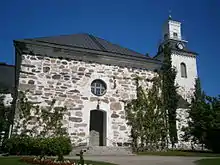Kuopio
Kuopio (/kuˈoʊpioʊ/ KUO-pi-ou,[7] Finnish: [ˈkuo̯pio] ⓘ) is a Finnish city and municipality located in the region of Northern Savonia. It has a population of 123,818,[4] which makes it the 8th most populous municipality in Finland. Along with Joensuu, Kuopio is one of the major urban, economic, and cultural hubs of Eastern Finland. At the end of 2018, its urban area had a population of 89,307.[8]
Kuopio | |
|---|---|
City | |
| Kuopion kaupunki Kuopio stad City of Kuopio | |
 Clockwise from top-left: the cityscape of the center, the Puijo Tower, the Kuopio Market Hall, the Kuopio Marina, the Governor Palace, the Väinölänniemi Beach, the Technopolis MicroTower, and the Kuopio City Hall. | |
 Coat of arms | |
| Nickname: | |
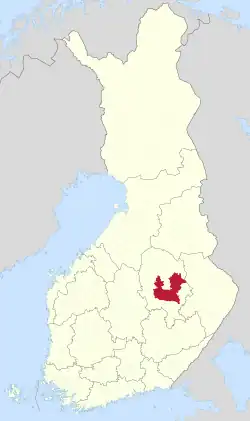 | |
| Coordinates: 62°53′33″N 27°40′42″E | |
| Country | Finland |
| Region | Northern Savonia |
| Sub-region | Kuopio |
| Settled | 1653 |
| Charter | 17 November 1775 |
| Government | |
| • City manager | Soile Lahti |
| Area (2018-01-01)[3] | |
| • Total | 4,326.35 km2 (1,670.41 sq mi) |
| • Land | 1,597.39 km2 (616.76 sq mi) |
| • Water | 719.85 km2 (277.94 sq mi) |
| • Rank | 18th largest in Finland |
| Population (2023-10-26)[4] | |
| • Total | 123,818 |
| • Rank | 8th largest in Finland |
| • Density | 77.51/km2 (200.7/sq mi) |
| Population by native language | |
| • Finnish | 95% (official) |
| • Swedish | 0.1% |
| • Others | 4.9% |
| Population by age | |
| • 0 to 14 | 14.5% |
| • 15 to 64 | 63.8% |
| • 65 or older | 21.7% |
| Time zone | UTC+02:00 (EET) |
| • Summer (DST) | UTC+03:00 (EEST) |
| Postal code | FI-70101 |
| Website | kuopio.fi |
Kuopio has a total area of 4,326.35 square kilometres (1,670.41 sq mi), of which 719.85 km2 (277.94 sq mi) is water[3] and half is forest. Though the city's population is spread out 78/km2 (200/sq mi), the city's urban areas are populated comparably densely (urban area: 1,618 /km²),[9] making Kuopio Finland's second-most densely populated city.
Kuopio is known nationwide as one of the most important study cities and centers of attraction and growth. [10][11][12] The city's history has been characterized by several municipality mergers since 1969, as a result of which Kuopio now includes much countryside; Kuopio's population surpassed 100,000 when the town of Nilsiä joined the city at the beginning of 2013. When Maaninka joined Kuopio at the beginning of 2015, Kuopio became Finland's largest milk producing community and Finland's second largest beef producing community. In addition, at the end of the 2010s, Kuopio was noted for numerous large projects, which are the largest nationwide after the Helsinki's metropolitan area.[13] With the large tourist center in Tahkovuori, Kuopio has also grown into a major tourist city. Kuopio Airport, located in the Siilinjärvi municipality, is Finland's fifth-busiest airport, with over 235,000 passengers in 2017.[14]
According to Kuntarating 2017 survey, Kuopio has the most satisfied residents among the 20 largest cities,[15] and according to the 2018 survey, Kuopio is the best city for real estate investors.[16] In the Kuntien imago 2018 survey, Kuopio ranks second among large cities of Finland after Seinäjoki of South Ostrobothnia.[17] In T-media's attraction and influence of the ten biggest cities study in 2021, 2022 and 2023, Kuopio is the second most attractive city in Finland, with Tampere holding the first place.[18][19][20]
Kuopio was the European Region of Gastronomy in 2020.[21][22] It is also known as home of Kalakukko, a traditional food of Savonia,[23] which is why Kuopio is also known by the nickname the "Promised Land of Kalakukko".[1][2]
Etymology
Several explanations are behind the name Kuopio. The first is that in the 16th century, a certain influential person named Kauhanen in Tavinsalmi changed his name to Skopa and the people's pronunciation was Coopia and finally Cuopio. The second explanation is that it comes from the verb kuopia, meaning "paw", as when a horse paws the ground with its hoof. A third explanation is that it came from a certain Karelian man's name Prokopij, from Ruokolahti in the Middle Ages.[24] This explanation is the most likely, and is supported by the Research Institute for the Languages of Finland.[25][26]
Heraldry

The coat of arms of Kuopio was designed in 1823 based on a drawing by the town councilor Karl Hårdh[27] or possibly his artist son, Adolf Hårdh.[28] The coat of arms was approved for use in 1823 by the Kuopio Magistrate in accordance with the order of Alexander I of Russia.[29][30] The coat of arms building, which represents Kuopio Cathedral, has often been mistakenly considered to be Kuopio City Hall, completed in 1886.[28]
The current design of the coat of arms is the work of architect Seppo Ruotsalainen.[28] The coat of arms in its current form was approved at a meeting of Kuopio City Council on 25 November 1957, and the Ministry of the Interior confirmed the coat of arms and its explanation on 12 June 1958.[31]
History
In the 1550s, under the influence of Mikael Agricola, a church and a parish were founded in Kuopionniemi. Governor Peter Brahe founded the city of Kuopio in 1653, but the official date is recognized as 17 November 1775, when King Gustav III of Sweden ordered the formal establishment of the city.[32]
The period of Russian rule (1809–1917) brought notable transportation development within Eastern Finland. The Saimaa Canal (1856) opened up a summer route towards the Baltic Sea, and the Savonia railway (1889) improved transport in winter.[32]

After World War II, the city's population grew significantly, due in part to the settlement of Karelian evacuees and the high birth rate. The rapid growth of the population forced the expansion of schools; at the end of the 1940s, support was also provided for school transports[33] and the provision of free school meals (the poor people had received it in Kuopio since 1902).[34] The large number of young people and the lack of activities for youths also gave rise to outbreaks of violence in the city, such as the Kuopio Market Riot in September 1965 which was a spontaneous event instigated by two young men; 30 young people were fined for rioting.[35][36] In the 1960s, the first construction of the actual suburb, Puijonlaakso, began. Since then, the new areas have each grown in turn: in the 1960s, Puijonlaakso and Tiihotar (as part of Saarijärvi); In the 1970s Saarijärvi, Kelloniemi and Levänen; In the 1980s, Jynkkä and Neulamäki.
The municipality of Maaninka joined the city of Kuopio in 2015, the town of Nilsiä in 2013, and Karttula[37] in 2011, as did Vehmersalmi in 2005, Riistavesi in 1973, and Kuopion maalaiskunta in 1969.[32]
Geography
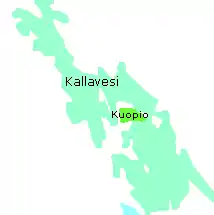
The city is surrounded by Lake Kallavesi,[38] and several parts of it are built on islands. With an area of 472.76 square kilometres (182.53 sq mi) Lake Kallavesi is the tenth largest lake in Finland. In the wake of the Yoldia Sea, which followed the Weichselian glaciation and preceded the Baltic Sea, there are ancient beaches up to 140 m above the current sea level, of which the current Lake Kallavesi is 82 m above sea level.[39] Kuopio's ample waterfronts and islands are also used in the Saaristokaupunki (lit. Archipelago city) -project, the biggest residential area currently being built in Finland.[40] Saaristokaupunki will accommodate a total of 14,000 inhabitants in 2015. All houses will be situated no more than 500 metres (1,600 ft) from the nearest lakeshore.[41]
Kuopio Market Square is the undisputed center of the city[38] and the city center follows a densely built grid pattern with several parks and narrow gutter streets.[42] The environment of the city is quite distinctive; the surface shapes of the waterfront-lined center are so variable that a flat property is a desired rarity.[43] The settlement has spread outside the center of Kuopio according to a dense and sparse finger model that is affordable for public transport,[44] and the new districts have been built in a municipal drive at once; for example, the Saaristokaupunki was banned for building for the previous 25 years,[45] and this Kuopio zoning tradition has a long history.[45] Due to the above-mentioned factors, the population density of the Kuopio city center is the highest in Finland.[46]
With the surrounding lakes, the shoreline in Kuopio is 4,760 kilometers.[47] The terrain is also characterized by rich forests, and the clear center of the Kuopio's lund forest is mainly located in the area between Kuopio, Nilsiä and Siilinjärvi.[48][49] Of the Finnish municipalities, Kuopio has the second largest number of summer cottages and holiday homes. In 2013, the number of summer cottages was 8,684. The number of summer homes in Kuopio has increased in recent years due to municipal associations.[50] Due to the abundance of water bodies, Kuopio also has a remarkably favorable climate compared to the latitude. The annual sum of the effective temperature is about as high in Kuopio as in places further south than, for example, Tampere and Lahti.[51]
Subdivisions
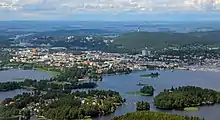

There are more than 50 districts and villages in Kuopio.[43]
- Väinölänniemi
- Vahtivuori
- Maljalahti
- Multimäki
- Kuopionlahti
- Hatsala
- Niirala
- Haapaniemi
- Itkonniemi
- Männistö
- Linnanpelto
- Saarijärvi
- Puijonlaakso
- Savilahti
- Peipposenrinne
- Inkilänmäki
- Särkiniemi
- Kettulanlahti
- Rahusenkangas
- Rönö
- Rypysuo
- Päiväranta
- Julkula
- Sorsasalo
- Kelloniemi
- Levänen
- Jynkkä
- Neulamäki
- Puijo
- Niuva
- Neulaniemi
- Kolmisoppi
- Neulalampi
- Petonen
- Litmanen
- Pirtti
- Pitkälahti
- Saaristokaupunki
- Lehtoniemi
- Rautaniemi
- Hiltulanlahti
- Kiviharju
- Vanuvuori
- Melalahti
- Kurkimäki
- Vehmersalmi
- Karttula
- Nilsiä
- Tahko
- Maaninka
- Keskisaari
- Juankoski
- Säyneinen
- Puutossalmi
- Pellesmäki
Climate
| Kuopio | ||||||||||||||||||||||||||||||||||||||||||||||||||||||||||||
|---|---|---|---|---|---|---|---|---|---|---|---|---|---|---|---|---|---|---|---|---|---|---|---|---|---|---|---|---|---|---|---|---|---|---|---|---|---|---|---|---|---|---|---|---|---|---|---|---|---|---|---|---|---|---|---|---|---|---|---|---|
| Climate chart (explanation) | ||||||||||||||||||||||||||||||||||||||||||||||||||||||||||||
| ||||||||||||||||||||||||||||||||||||||||||||||||||||||||||||
| ||||||||||||||||||||||||||||||||||||||||||||||||||||||||||||
Kuopio falls in the subarctic climate zone (Köppen "Dfc"), closely bordering on continental due to its warm summers. Winters are long and cold, with average highs staying below freezing from November until March, and summers are short and relatively mild. Most precipitation occurs in the late summer and early fall. The summers are relatively warm for its latitude, especially the lows. This is due to influence from the lake, making it much warmer on summer nights than in areas away from water. In winter, maritime moderation is eliminated as the lake freezes over.
| Climate data for Kuopio Airport (1981-2010 normals, extremes 1940-present) | |||||||||||||
|---|---|---|---|---|---|---|---|---|---|---|---|---|---|
| Month | Jan | Feb | Mar | Apr | May | Jun | Jul | Aug | Sep | Oct | Nov | Dec | Year |
| Record high °C (°F) | 7.9 (46.2) |
9.2 (48.6) |
13.3 (55.9) |
21.9 (71.4) |
28.6 (83.5) |
31.1 (88.0) |
33.8 (92.8) |
33.2 (91.8) |
25.8 (78.4) |
16.0 (60.8) |
11.1 (52.0) |
8.6 (47.5) |
33.8 (92.8) |
| Average high °C (°F) | −6.0 (21.2) |
−5.7 (21.7) |
−0.2 (31.6) |
6.4 (43.5) |
14.1 (57.4) |
18.9 (66.0) |
21.8 (71.2) |
18.9 (66.0) |
13.0 (55.4) |
6.3 (43.3) |
−0.1 (31.8) |
−3.9 (25.0) |
7.0 (44.5) |
| Daily mean °C (°F) | −9.2 (15.4) |
−9.2 (15.4) |
−4.1 (24.6) |
2.0 (35.6) |
9.1 (48.4) |
14.5 (58.1) |
17.5 (63.5) |
15.0 (59.0) |
9.7 (49.5) |
4.1 (39.4) |
−2.0 (28.4) |
−6.7 (19.9) |
3.4 (38.1) |
| Average low °C (°F) | −12.6 (9.3) |
−13.0 (8.6) |
−8.0 (17.6) |
−2.2 (28.0) |
4.3 (39.7) |
10.3 (50.5) |
13.6 (56.5) |
11.7 (53.1) |
7.0 (44.6) |
2.1 (35.8) |
−4.1 (24.6) |
−9.7 (14.5) |
−0.1 (31.9) |
| Record low °C (°F) | −39.3 (−38.7) |
−37.0 (−34.6) |
−33.0 (−27.4) |
−20.9 (−5.6) |
−8.2 (17.2) |
0.1 (32.2) |
4.7 (40.5) |
2.7 (36.9) |
−4.9 (23.2) |
−15.0 (5.0) |
−27.6 (−17.7) |
−41.1 (−42.0) |
−41.1 (−42.0) |
| Average precipitation mm (inches) | 48 (1.9) |
36 (1.4) |
36 (1.4) |
30 (1.2) |
46 (1.8) |
67 (2.6) |
80 (3.1) |
75 (3.0) |
53 (2.1) |
56 (2.2) |
52 (2.0) |
51 (2.0) |
630 (24.7) |
| Average precipitation days | 11 | 9 | 9 | 7 | 9 | 10 | 11 | 11 | 10 | 11 | 11 | 11 | 120 |
| Source: Finnish Meteorological Institute[52] | |||||||||||||
Demographics
Population
| Year | Pop. | ±% |
|---|---|---|
| 1815 | 1,087 | — |
| 1840 | 2,071 | +90.5% |
| 1850 | 2,849 | +37.6% |
| 1860 | 4,066 | +42.7% |
| 1870 | 5,639 | +38.7% |
| 1880 | 6,871 | +21.8% |
| 1890 | 8,882 | +29.3% |
| 1900 | 11,723 | +32.0% |
| 1910 | 15,845 | +35.2% |
| 1920 | 18,725 | +18.2% |
| 1930 | 24,082 | +28.6% |
| 1940 | 25,157 | +4.5% |
| 1950 | 33,353 | +32.6% |
| 1960 | 44,911 | +34.7% |
| 1970 | 63,766 | +42.0% |
The city of Kuopio has 123,818 inhabitants, making it the 8th most populous municipality in Finland. The region of Kuopio is the 7th largest in Finland, after the regions of Helsinki, Tampere, Turku, Oulu, Jyväskylä and Lahti. Kuopio is home to 2% of Finland's population. 5% of the population has a foreign background, which is below the national average.[54]
| Year | Population |
|---|---|
| 1980 | 99,687 |
| 1985 | 102,686 |
| 1990 | 104,675 |
| 1995 | 108,199 |
| 2000 | 108,890 |
| 2005 | 110,208 |
| 2010 | 112,336 |
| 2015 | 116,921 |
| 2020 | 119,379 |
Languages
Population by mother tongue (2022)[54]
Kuopio is the fourth largest monolingual Finnish-speaking municipality in Finland after Tampere, Oulu and Jyväskylä. The majority of the population - 116,431 people or 95.0% - speak Finnish as their first language. In Kuopio, 140 people, or 0.1% of the population, speak Swedish. 4.9% of the population of Kuopio have a mother tongue other than Finnish or Swedish.[54] As English and Swedish are compulsory school subjects, functional bilingualism or trilingualism acquired through language studies is not uncommon.
At least 100 different languages are spoken in Kuopio. The most common foreign languages are Russian (1.3%), Arabic (0.6%), English (0.3%) and Estonian (0.2%).[54]
Immigration
| Population by country of birth (2022)[54] | ||
| Nationality | Population | % |
|---|---|---|
| 116576 | 95.1 | |
| 958 | 0.8 | |
| 521 | 0.4 | |
| 326 | 0.3 | |
| 263 | 0.2 | |
| 245 | 0.2 | |
| 218 | 0.2 | |
| 179 | 0.1 | |
| 162 | 0.1 | |
| 142 | 0.1 | |
| 139 | 0.1 | |
| Other | 2,865 | 2.3 |
In 2022, 6,127 people with a migrant background lived in Kuopio, representing 5% of the population.[note 1] There are 6,018 residents who were born abroad, which makes up 4.9% of the population. The number of foreign citizens in Kuopio is 3,924.[56] Most foreign-born citizens come from the former Soviet Union, Russia, Sweden, Thailand, and Syria.[54]
The relative proportion of immigrants in Kuopio's population is below the national average. It is lower than in the major Finnish cities of Helsinki, Espoo, Tampere, Vantaa or Turku. Nevertheless, the Kuopio's new residents are increasingly of foreign origin. This will increase the proportion of foreign residents in the coming years.
Religion
In 2022, the Evangelical Lutheran Church was the largest religious group with 67.1% of the population of Kuopio. Other religious groups accounted for 3.8% of the population. 29.1% of the population had no religious affiliation.[54]
The largest church denomination in Finland, Lutheran Church has a diocese in Kuopio, which is shepherded by bishop Jari Jolkkonen.[57] One of the most significant Lutheran churches in the city is the Kuopio Cathedral, completed in 1816.[58]
Kuopio is home of the Finnish Orthodox Church where its primate, archbishop of Karelia and all Finland Leo (Makkonen) is seated. This is an autonomous jurisdiction affiliated with the Patriarchate of Constantinople. It is the only mainstream Orthodox faction to celebrate Easter on the Latin date. The late Archbishop Paul had been successful in producing literature of popular theology. The city is also the location of RIISA- Orthodox Church Museum of Finland.
Kuopio also has an Islamic mosque.[59] Muslims from various parts of the world and certain Finnish Muslims live in Kuopio.
The town is also home to the first Burmese Buddhist monastery in Finland, named the Buddha Dhamma Ramsi Monastery.[60][61]
Economy
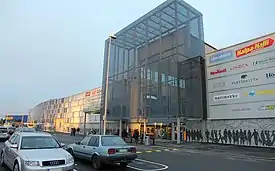
Kuopio's economic structure is very diverse. In 2008, there were about 4,200 enterprises in Kuopio,[62] of which approximately 180 were export companies.[63] These provided about 45,000 jobs.[63] In 2016, this grew to a total of about 5,050 companies, of which more than 190 also trade abroad. There are a total of 50,877 jobs. The business service of the City of Kuopio plays a significant role in the development of Kuopio's business life. The business service promotes the development of companies operating in Kuopio and improves the operating environments of companies. The most important thing in developing operating environments is to improve the supply of estate and business premises. The Kuopio University Hospital (KUH) is Kuopio's second largest employer after the City of Kuopio; in 2011, KUH employed a total of 4,113 people.[64]
Tourism is of great importance to Kuopio's business life;[65] the Rauhalahti camping site is one indication of Kuopio's expertise, as it is the only five-star camping site in Finland.[65] The city has also a comprehensive hotel offer for tourism, one of the most notable is Hotel Savonia, part of the Best Western hotel chain, in the Puijonlaakso district. Arranging accommodation and program services gives many jobs. Kuopio's Entrepreneurs (Kuopion Yrittäjät), the local association of Savonia Entrepreneurs (Savon Yrittäjät), operates in Kuopio.

The most significant recent business projects are the centralization of Honeywell's Finnish operations in Kuopio, the completion of Ark Therapeutics' gene medicine plant, the marine industry concentration built by Bella Boats at the Marine Park in Haapaniemi's Siikaniemi and the construction of Junttan's EUR 15 million assembly plant at Kylmämäki at the end of 2008. The site of Junttan's current factory in Särkilahti will have space for a large shopping center. The 9.7-hectare plot purchased by Savocon and TKD Finland for EUR 11 million has a building right for 58,500 square meters. The two companies plan to invest a total of about 40 million euros in the project.[66] A significant industrial player is also Savon Sello company in Sorsasalo, which is currently owned by Powerflute Oyj. One of the biggest projects and investments of recent years is the preparation of the construction of Finnpulp's largest and most modern softwood pulp mill in Kuopio.[67] The most significant retail investments are the Prisma hypermarket completed in December 2007 and the Päiväranta's K-Citymarket completed in August 2008. A hardware store Kodin Terra was opened in Pitkälahti, as well as the Ikano Group's Matkus Shopping Center in the Hiltulanlahti area in November 2012[68] and an IKEA department store in May 2013.[69]
Culture
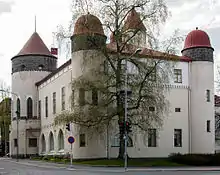
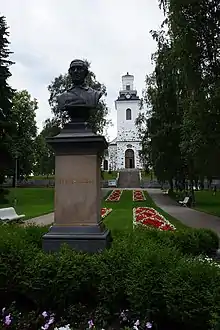
Kuopio is known as the cultural center of Eastern Finland. One of Kuopio's most important cultural venues are the Kuopio Museum, the Kuopio Art Museum and the Kuopio City Theatre in the city center. A wide range of musical (from kindergarten to doctorate-level studies) and dance education is available and the cultural life is active. Notable events include ANTI – Contemporary Art Festival, Kuopio Dance Festival, Kuopio Rockcock, Kuopio Wine Festival, Kuopio Marathon and Finland Ice Marathon in winter. A notable place, however, to enjoy the local flavor of Kuopio life and food is Sampo, a fish restaurant loved by locals and tourists as well.
Kuopio is known for its association with a national delicacy, Finnish fish pastry (Kalakukko), and the dialect of Savo, as well as the hill of Puijo and the Puijo tower.[38] Besides being a very popular outdoor recreation area, Puijo serves also as a stage for a yearly World Cup ski jumping competition.[38]
In inhabitants of Kuopio have a special reputation: they are known as jovial and verbally joking. Within the Savo culture, the onus is placed on the listener to interpret the story. People of the Kuopio region and Eastern Finland have always had many health problems and the mortality has been higher than on an average in Finland. Because of this, Eastern Finland has been a hotspot for Public Health studies. The North Karelia Project by the University of Kuopio in coordination with the National Public Health Institute and the World Health Organization, beginning in the 1970s was one of its first steps towards world class research. Niuvanniemi a historical psychiatric hospital is also located in the western part of the city in the Niuva district.[70]
During the 2000s, Kuopio has placed very well in a number of image, popularity and city-attractiveness surveys. In 2007 it was placed third, behind Tampere and Oulu.
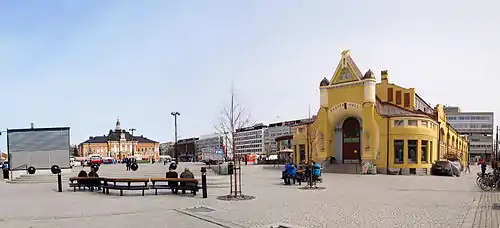
Sports
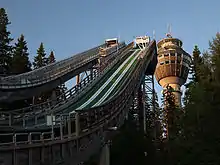
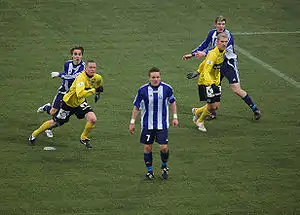
Kuopio bid for the 2012 Winter Youth Olympics, a youth sports festival in the tradition of the Olympics. It became a finalist in November 2008, but ultimately lost to Innsbruck, Austria. Kuopio's image as a small city with a large University and many active young people was considered a model of what the International Olympic Committee seeks for the Games.[71]
- KalPa (ice hockey)[38]
- KuPS (football)
- Kuopion Taitoluistelijat (figure skating)
- Puijon Hiihtoseura (skiing, ski jumping, nordic combined, biathlon)
- Puijon Pesis (pesäpallo)
- Kuopion Reippaan voimistelijat (gymnastics)
- Finland Ice Marathon (ice skating event)
- Kuopio Steelers (american football)
- Kuopio Skating club, Kuopion Luisteluseura KuLs (figure skating)
- Welhot (floorball)
- Linkki (basketball)
Transport
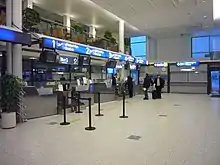
The city has a nationally unique feature in its street network, where every other street is reserved for pedestrian and cycle traffic,[72] so-called "rännikatu" (derived from the Swedish gränd, alley). These streets provide pedestrians a calm environment away from vehicular traffic.[73] This setup dates back to Kuopio's first town plan by Pehr Kjellman in 1776. Originally, rännikadut were created as a fire barrier to prevent a possible fire escalating in a mainly wood-constructed city.[74]
Two Finnish highways cross Kuopio: Finnish national road 5 (Vt 5; part of E63 in the northern side of city), which extends south to Helsinki and north to Sodankylä, and Finnish national road 9 (Vt 9; part of E63 in the western side of city), which extends west to Turku and east to the Niirala checkpoint on the Finnish-Russian border. The Blue Highway passes through Kuopio. It is an international tourist route from Mo i Rana, Norway to Pudozh, Russia via Sweden and Finland.
Long-distance transport connections from Kuopio include Pendolino and InterCity trains from Kuopio railway station to several destinations around Finland, operated by VR, as well as multiple daily departures from Kuopio Airport on Finnair to Helsinki. The passenger harbour of the port of Kuopio, located on the shore of Lake Kallavesi, is the busiest port for passenger traffic in the Vuoksi drainage basin and the Finnish Lakeland.[75][76]
Education
| University | Students |
|---|---|
| University of Eastern Finland | 6 229[77] |
| Savonia University of Applied Sciences | 5 000[78] |
| HUMAK University of Applied Sciences | ~150 |
| Sibelius Academy | ~100 |
Kuopio has always been a city of education. Some of the first schools offering education in Finnish (such as the School for the Blind in 1871, and the Trade School in 1887) were established in Kuopio. Currently the most important institutions are the University of Eastern Finland, the Savonia University of Applied Sciences, Vocational College of Northern Savonia and the Kuopio department of the Sibelius Academy. One of the oldest schools in the city is Kuopio Lyceum High School, which was officially established in 1872, but was originally built in 1826 and designed by Carl Ludvig Engel.
Kuopio is known as a strong center of health (e.g. it has the biggest yearly enrollment rate of medical students in Finland), pharmacy, environment, food & nutrition (all legalized Clinical and Public Health Nutritionists in Finland graduate from the University of Eastern Finland), safety (education in Emergency Services is centered in Kuopio[79]) and welfare professions, as the major organisations University of Kuopio (now part of the University of Eastern Finland since January 2010.[80]), Savonia University of Applied Sciences and Technopolis Kuopio are particularly oriented to those areas.
Notable people

- Juhani Aho
- Pertti Ahokas
- Martti Ahtisaari
- Minna Canth
- Pekka Halonen
- Janne Happonen
- Matti Hautamäki
- Marko Hietala
- Zachary Hietala
- Olli Jokinen
- Kasperi Kapanen
- Sami Kapanen
- Elina Karjalainen
- Mika Kojonkoski
- H. Olliver Twisted
- Hannes Kolehmainen
- Lasse Lehtinen
- Paavo Lipponen
- Paavo Lötjönen
- Emmi Mäkelin
- Archbishop Leo
- Iivo Niskanen
- Martti Nissinen
- Petri Partanen
- Pertti "Spede" Pasanen
- Paavo Ruotsalainen
- Aarno Ruusuvuori
- Aulis Rytkönen
- Tuomo Saikkonen
- Päivi Setälä
- Sanna Sillanpää
- Alma (Finnish singer)
- Johan Vilhelm Snellman
- Samuli Suhonen
- Kimmo Timonen
- Janne Tolsa
- Jenni Vartiainen
- Brothers von Wright: Magnus, Wilhelm and Ferdinand
- Ilpo Väisänen
International relations
Kuopio is twinned with 15 cities around the world. It also has one twin county, Lääne-Viru County, Estonia.[81]
Twin towns – Sister cities
See also
Notes
- Statistics Finland classifies a person as having a "foreign background" if both parents or the only known parent were born abroad.[55]
References
- "Kuopio Region – Unexpected encounters by Kirjakaari - Issuu". Issuu.com. 26 February 2016. Retrieved 30 June 2022.
- "Demonurkka vol. 52 (vk 6/2017)". Kaaoszine.fi. 12 February 2017. Retrieved 30 June 2022.
- "Area of Finnish Municipalities 1.1.2018" (PDF). National Land Survey of Finland. Retrieved 30 January 2018.
- "Preliminary population statistics 2023, September". StatFin. Statistics Finland. Retrieved 26 October 2023.
- "Demographic Structure by area as of 31 December 2022". Statistics Finland's PX-Web databases. Statistics Finland. Retrieved 6 September 2023.
- "Population according to age (1-year) and sex by area and the regional division of each statistical reference year, 2003–2020". StatFin. Statistics Finland. Retrieved 2 May 2021.
- "Kuopio". Lexico UK English Dictionary. Oxford University Press. Archived from the original on 26 August 2022.
- "Väestö 31.12. muuttujina Vuosi, Taajama ja Tiedot". Tilastokeskuksen PX-Web tietokannat (in Finnish). Retrieved 13 January 2021.
- "Taajamissa asuu 84 prosenttia väestöstä" (in Finnish). Statistics Finland. 15 January 2008. Retrieved 7 January 2009.
Tiheimmin asuttu oli Helsingin keskustaajama, jossa oli 1 690 asukasta maaneliökilometrillä. Seuraavaksi tiheimmin asuttuja olivat Kuopion keskustaajama (1 618 as./maa-km2)
- "Hypo: Tässä ovat Suomen 10 kasvukeskusta". Arvopaperi.fi. Retrieved 30 June 2022.
- "Kuopio meni Helsingin ohi vetovoimaisuudessa – kaupunginjohtaja: "Pitkäjänteinen työ näkyy"". Yle.fi. 30 March 2016. Retrieved 30 June 2022.
- "Pääkirjoitus | Kuopio onnistui nousemaan Itä-Suomen aluekeskukseksi". Hs.fi. 20 November 2017. Retrieved 30 June 2022.
- "Tällainen on Kuopio kymmenen vuoden kuluttua - Viikkosavo". Archived from the original on 11 September 2018. Retrieved 3 June 2020.
- "Finavia's Air Traffic Statistics 2010" (PDF). Vantaa: Finavia. pp. 7, 9. Archived from the original (PDF) on 24 January 2012. Retrieved 15 July 2011.
- "EPSI finlandKuntarating 2017 - EPSI finland". Archived from the original on 10 June 2020. Retrieved 10 June 2020.
- Alkula, Maarit (18 July 2018). "Tutkimus: Asuntosijoittajan paras kaupunki on nyt Kuopio – Varoitus kiinnostuksen lopahtamisesta". Uusisuomi.fi. Retrieved 30 June 2022.
- "Seinäjoella on paras imago". Taloustutkimus.fi. Retrieved 30 June 2022.
- Kuopio on Suomen toiseksi vetovoimaisin kaupunki, ainoastaan Tampere kiri edelle – YLE, 17 March 2021. (in Finnish)
- Kuopio on Suomen toiseksi vetovoimaisin kaupunki – YLE, 8 April 2022. (in Finnish)
- Hurme, Anu (29 March 2023). "Tampere listattiin jo kolmatta kertaa Suomen vetovoimaisimmaksi kaupungiksi – muista suurista kaupungeista vain Oulu paransi tulostaan" [Tampere was listed as the most attractive city in Finland for the third time – of the other big cities, only Oulu improved its result]. Yle (in Finnish). Retrieved 29 March 2023.
- "European region of gastronomy Kuopio 2020". Tastesavo.fi. Archived from the original on 18 July 2020. Retrieved 15 July 2020.
- "Kuopio - muutakin kuin kalakukkoa 🐟🐓". Retrieved 30 June 2022 – via YouTube.
- The Rough Guide to Finland. Rough Guides, 2010. ISBN 1848362579
- "Kuopion kaupunki". 26 January 2010. Archived from the original on 26 January 2010. Retrieved 30 June 2022.
- Raatikainen, Riitta (16 December 2007). "Varkaudesta Puutokseen". Savon Sanomat (in Finnish) (344): 38.
- Pekka Lappalainen (1982). Kuopion historia 1 (in Finnish). Kustannuskiila. pp. 35–36. ISBN 951-657-097-6.
- "Karl Mikael Hårdh". Genos (in Finnish). Suomen sukututkimusseura. Archived from the original on 9 August 2007. Retrieved 26 March 2021.
- Professor Jussi T. Lappalainen (23 December 2009). "Vanhassa vara parempi?". Savon Sanomat (in Finnish). p. 2.
- Бойко Дм. А. Геральдика Великого Княжества Финляндского. – Запорожье, 2013.
- "Kuopion vaakuna" (in Finnish). City of Kuopio. Archived from the original on 19 November 2007. Retrieved 26 March 2021.
- "Ennen 8.4.1949 annettua kunnanvaakunalakia vahvistetut vaakunat ja vahvistamispäätökset I:10 Kuopio". Kansallisarkiston digitaaliarkisto (in Finnish). Retrieved 26 March 2021.
- "History and basic data". Kuopio in Brief. City of Kuopio. Archived from the original on 4 November 2016. Retrieved 2 November 2016.
- "Kaupungin elämää 1947". Archived from the original on 27 December 2007. Retrieved 12 June 2020.
- "Koulun arkea 1872". Archived from the original on 7 August 2016. Retrieved 12 June 2020.
- "Torimellakka Kuopiossa 1965". Yle.fi. 22 April 2010. Retrieved 30 June 2022.
- "Erikoislehti kertoo: Miksi nuoriso riehui Kuopion torilla?". Savonsanomat.fi. 13 January 2015. Retrieved 30 June 2022.
- "Karttula sulautuu Kuopioon" & "Karttula ja Kuopio yhteen". Myöhänen, Pentti & Manner, Matias & Hartikainen, Jarno; Savon Sanomat. 1 July 2008. pp. 1 and 3.
- Houston, Craig (19 April 2012). "A city in the heart of Savo". Helsinki Times. Retrieved 2 November 2022.
- Katainen, Milla (8 June 2008). "Huipulla, vaikka oikeasti joen pohjalla". Sunnuntaisuomalainen (in Finnish). p. 38.
- "Kuopion korkein asuinkerrostalo nousi harjakorkeuteen". Suomen Kiinteistölehti. 16 October 2008. p. 14. Archived from the original on 24 February 2009.
- "Kallaveden syleilyssä". Saaristokaupunki. Kuopio. Archived from the original on 29 January 2009. Retrieved 7 January 2009.
- "Kuopion rännikaduista tehdään nykyaikaa mennyttä kunnioittaen". Yle.fi. 2 October 2009. Retrieved 30 June 2022.
- Kuopion kaupungin tekninen virasto: Kuopio 2009 suunnittelee ja rakentaa (2009)
- "Kuopion Saaristokaupunki – kasvusuuntana täydennysrakentaminen" (PDF). Siseministeerium.ee. Archived from the original (PDF) on 20 July 2011. Retrieved 3 June 2020.
- Leo Kosonen: Kuopio 2015: Jalankulku-, joukkoliikenne- ja autokaupunki. Ympäristöministeriö, 2007. ISBN 978-952-11-2852-3
- "Kuopio-esittely - Kuopion kaupunki". 7 January 2015. Archived from the original on 7 January 2015. Retrieved 30 June 2022.
- Pohjois-Savon metsä- ja ympäristökertomus 2007 (in Finnish). Metsäkeskus. 2008. p. 9.
- Ihantola, Anna-Riikka (15 June 2008). "Lähes kaikki Kuopion lehtotyypit luokiteltiin uhanalaisiksi". Savon Sanomat (in Finnish). Retrieved 17 January 2021.
- "Asuminen - Kuopion kaupunki". Archived from the original on 6 January 2015. Retrieved 19 June 2020.
- Spectrum tietokeskus (1978), p. 185 (in Finnish)
- Tilastoja Suomen ilmastosta 1981 - 2010. Finnish Meteorological Institute. 14 August 2012. ISBN 9789516977655.
- "SUOMEN MAAKUNTIEN ILMASTO" (PDF). Helda.helsinki.fi. Retrieved 30 June 2022.
- "Number of foreign-language speakers grew by nearly 38,000 persons". Statistics Finland. 31 May 2023. Retrieved 12 September 2023.
- "Persons with foreign background". Statistics Finland. Retrieved 18 September 2023.
- "Population structure 2000-2022, urban-rural classification". Statistics Finland. 26 May 2023. Retrieved 12 September 2023.
- Koskinen, Jerri (6 May 2012). "Jari Jolkkonen vihittiin Kuopion piispan virkaan". Savon Sanomat. Archived from the original on 18 October 2015. Retrieved 11 May 2012.
- "Charming beauty of churches". 12 April 2011. Archived from the original on 12 April 2011. Retrieved 30 June 2022.
- "Savon Islamilainen Yhdyskunta". IslamicFinder.org. Retrieved 30 June 2022.
- "Buddhist Channel | Buddhism News, Headlines | World | Burmese Buddhist monastery opens in Finland". Buddhistchannel.tv. 5 January 2009. Retrieved 16 September 2011.
- "Burmalaiset keräsivät vuosikausia rahaa buddhalaisluostarin perustamiseksi Savoon – munkki Ven Pannasami: "Me tavoittelemme myös suomalaisia"". Yle.fi. 20 July 2019. Retrieved 30 June 2022.
- Kuopion työpaikat ja elinkeinorakenne 1.1.2008 (PDF). Kuopion kaupungin yrityspalvelu. 2008. pp. 1–2. Archived from the original (PDF) on 7 December 2010. Retrieved 9 January 2009.
- "Elinkeinoelämä". City of Kuopio. 7 October 2008. Archived from the original on 26 February 2009. Retrieved 9 January 2009.
- "Suurimmat työnantajat Kuopiossa 1.1.2011" (PDF) (in Finnish). City of Kuopio. Retrieved 20 January 2022.
- "Elinkeinoelämä - Kuopion kaupunki". Archived from the original on 28 June 2014. Retrieved 23 January 2021.
- Juutilainen, Jouko (19 January 2008). ""Junttanin tiloihin kauppajätti" ja "Moottoritien varteen uusi kauppajätti"". Savon Sanomat (in Finnish). No. 18.
- "Finnpulp - Finnpulp Oy". Finnpulp.fi (in Finnish). Retrieved 23 January 2021.
- "Kuopion karttapalvelu" (in Finnish). City of Kuopio. Retrieved 23 January 2021.
- "Kuopio". Ikano Retail Centres Finland Oy (in Finnish). Archived from the original on 10 November 2013. Retrieved 23 January 2021.
- "Official website of Niuvanniemi hospital". Niuva.fi. Archived from the original on 28 October 2020. Retrieved 30 June 2022.
- "Innsbruck and Kuopio Make Final Shortlist For 2012 Youth Olympic Winter Games". Archived from the original on 8 January 2012. Retrieved 30 June 2022.
- WP2: Accessibility, Synthesis Report (PDF). Universell utforming. 26 March 2004. p. 14. Archived from the original (PDF) on 25 March 2009. Retrieved 7 January 2009.
- Description of the Case Areas (PDF). VTT Technical Research Centre of Finland. 2 May 2002. p. 8.
- "Napoleon ja Kuopio: Kuninkaiden Kuopio". Memory of Northern Savonia. Museums of Northern Savonia. Archived from the original on 25 February 2009. Retrieved 11 January 2009.
- "Matkustajasatama | Kuopio". Kuopio.fi. Retrieved 30 June 2022.
- "Kuopio - information for tourists | Finland travel destinations". Visit-plus.com. Retrieved 30 June 2022.
- "Key Data for 2007". University of Kuopio. 2007. Archived from the original on 25 January 2009. Retrieved 9 January 2009.
- "In English". Savonia University of Applied Sciences. 2009. Archived from the original on 4 January 2011. Retrieved 9 January 2009.
- "Pelastusopisto - Tutustu toimintaamme". Pelastusopisto.fi. Retrieved 30 June 2022.
- "Steps leading to the establishment of the UEF". Archived from the original on 27 February 2013. Retrieved 30 June 2022.
- "Twin cities". City of Kuopio. Retrieved 21 August 2019.
External links
- Kuopio – Official website (in Finnish, Swedish, English, German, French, Spanish, and Russian)
- City of Kuopio – Another official website (in Finnish, Swedish, English, and German)
- KuopioInfo – Various resources about different areas of interest related to Kuopio History and Life (in Finnish, English, German, Russian, and Chinese)
- 360° panorama of Kuopio Marketplace
- Savonia University of Applied Sciences (in English)
- University of Eastern Finland (in English)
- KPY Novapolis Kuopio (in Finnish)
- Invest in Kuopio -factsheet (in English)
- Kuopio Mosque
- Satellite picture by Google Maps
